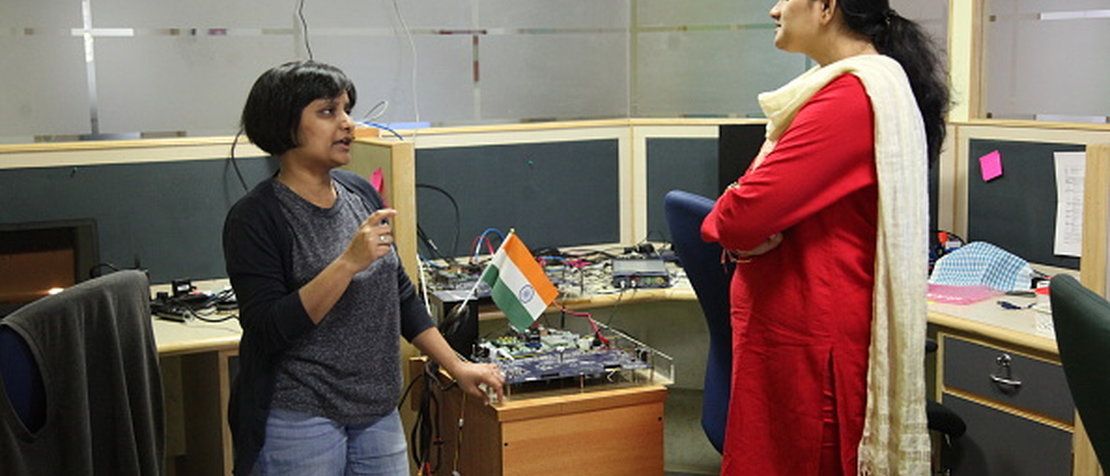
Meet Astrome: The deep tech start-up aiming to bridge India’s digital divide
India-based deep tech start-up Astrome sees its innovative wireless solution as a way to connect the country’s rural and semi-urban areas. Its use of millimetre wave wireless communication to provide fibre-like backhaul capacity for 4G and 5G infrastructure has won Astrome the SME Award in the Connectivity category at ITU Virtual Digital World, the 2020 online edition of leading UN tech event ITU Digital World. “We help telecom operators and governments bridge the digital divide by enabling them to deploy quality telecom infrastructure in rural and semi-urban areas at five times lower cost than fibre and an order of magnitude lower time of deployment,” said co-founder and CEO Dr Neha Satak, in a conversation with ITU News.
Delivering last-mile connectivity
Astrome’s first product is a multi-beam E-band radio called GigaMesh. By packing six point-to-point E-band radios in one, the cost of the device is distributed over multiple links. Astrome believes in Gigamesh’s potential to decongest dense urban networks and rapidly deploy 5G by extending broadband coverage in rural areas. In India, government initiatives have been working towards bringing connectivity to villages around the country, notes Satak.
“But the last mile of connectivity from a grama panchayat [village council] to a village is typically a distance of between 3 to 7 kilometres depending on the state. And that last mile is key to getting connectivity delivered to the villages,” she added.
To bridge the digital divide and unlock economic potential, Satak pointed out the importance of linking up village councils that are difficult to connect, while also connecting them by a backbone “which can be deployed in a matter of days, compared to the years fibre takes to get deployed.” According to Satak, “That’s where we believe we can play a major role in getting rural India fully connected.”
From satellite to the field
Astrome was not founded with the mission to connect rural India. They began as a company that wanted to build wireless technologies for the satellite communication domain. Their multibeam technology for low Earth orbit (LEO) satellites to deliver 10 times more capacity on the ground aimed to bridge digital divide using satellites. “Along the way, we realized that the technology can be much more effective today if we use it to bridge the last mile connectivity [gap] on the ground infrastructure itself. That’s how we took a pivotal decision in our journey about three years ago,” explains Satak. “[Gigamesh] can do the job of fibre but at one-fifth the cost. And it can be deployed in hours between two locations compared to the months it takes to deploy fibre.” Astrome is working towards overcoming regulatory barriers, added Satak. “The frequencies in which we operate will be opened up soon in India. There is some delay in that, but we are hoping that it will happen this year. The path we have taken is talking to the regulators,” she explained. The company has also shared their readiness to provide solutions with the government, and these have been received favourably, according to Satak. Astrome is also looking into entering markets where the frequencies in which they operate are open already. Satak and her team intend to keep their original ambition intact.
Astrome’s vision is to enable high-bandwidth, low-cost connectivity across land, air and sea by building terrestrial wireless and satellite communications products.
“Our ultimate goal is also to build satellite communication payloads and user ground terminals that can help make LEO constellations as effective as fibre in terms of cost,” said Satak.
Building credibility and trust in deep tech
Satak credits her team’s positive attitude towards problem solving for their success in creating an innovative deep tech solution. “If you think: ‘I can solve it,’ there’s always a way,” she said. But what made the project stand out in a competitive, global field at the ITU Digital World SME Awards? “We believe that we have won because our product can truly help telecom operators and governments deploy quality rural telecom infrastructure at record cost and time. The COVID-19 pandemic has highlighted the importance of rural connectivity and action to bridge the digital divide has [quickened] due to it,” Satak noted. “There is an opportunity for the world to move to a better telecom infrastructure in a short period of time,” she added.For Satak, the best part of the Awards was “the opportunity to present our solution to a diverse set of judges and audience”.
“This award is a strong validation that our technology and product is desired all around the world to bridge the digital divide,” explained Satak. “It gives [Astrome] encouragement to scale our business and reach its maximum potential. We are already using the award in our customer conversations to build credibility and trust,” she added. It’s a key benefit enjoyed by many Award winners over the six years of the programme at ITU Telecom events. Satak’s message for applicants this year? “Make the most of this fantastic opportunity to be on a world stage by submitting a good application.” The SME programme at ITU Digital World 2021, scheduled to take place in Ha Noi from 12 to 15 October 2021, will provide support, visibility, investment and networking potential to tech SMEs and start-ups from around the world. Applications for the ITU Digital World Awards 2021 will open in the second quarter. Learn more on how to take part in ITU Digital World as an SME here.
Image credit: Pallava Bagla/Corbis via Getty Images
